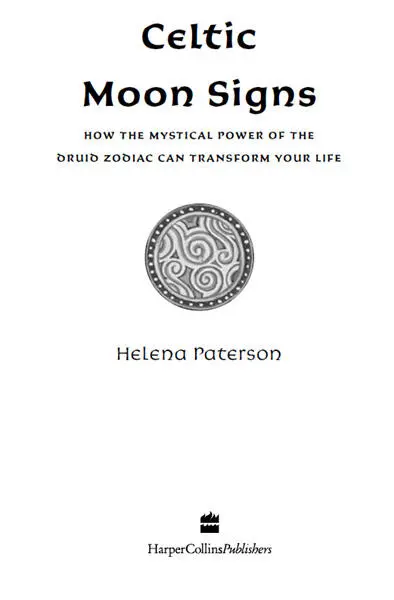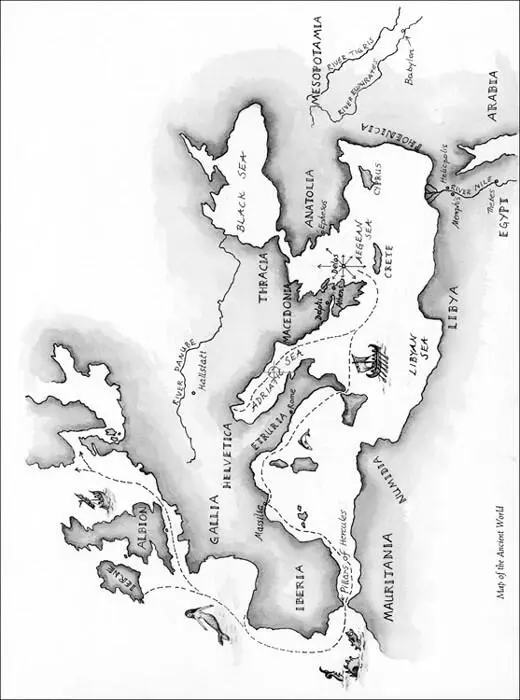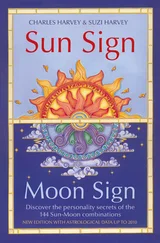
MAP Map Dedication Foreword: ‘A People of the Sea’ Introduction The Birch Tree Sign The Rowan Tree Sign The Ash Tree Sign The Alder Tree Sign The Willow Tree Sign The Hawthorn Tree Sign The Oak Tree Sign The Holly Tree Sign The Hazel Tree Sign The Vine Sign The Ivy Sign The Reed Sign The Elder Tree Sign Bibliography Index Acknowledgements Copyright About the Publisher

DEDICATION Dedication Foreword: ‘A People of the Sea’ Introduction The Birch Tree Sign The Rowan Tree Sign The Ash Tree Sign The Alder Tree Sign The Willow Tree Sign The Hawthorn Tree Sign The Oak Tree Sign The Holly Tree Sign The Hazel Tree Sign The Vine Sign The Ivy Sign The Reed Sign The Elder Tree Sign Bibliography Index Acknowledgements Copyright About the Publisher
This book is dedicated to the Faery or Fey people who still live among us.
Cover
Title Page
Map MAP Map Dedication Foreword: ‘A People of the Sea’ Introduction The Birch Tree Sign The Rowan Tree Sign The Ash Tree Sign The Alder Tree Sign The Willow Tree Sign The Hawthorn Tree Sign The Oak Tree Sign The Holly Tree Sign The Hazel Tree Sign The Vine Sign The Ivy Sign The Reed Sign The Elder Tree Sign Bibliography Index Acknowledgements Copyright About the Publisher
Dedication DEDICATION Dedication Foreword: ‘A People of the Sea’ Introduction The Birch Tree Sign The Rowan Tree Sign The Ash Tree Sign The Alder Tree Sign The Willow Tree Sign The Hawthorn Tree Sign The Oak Tree Sign The Holly Tree Sign The Hazel Tree Sign The Vine Sign The Ivy Sign The Reed Sign The Elder Tree Sign Bibliography Index Acknowledgements Copyright About the Publisher This book is dedicated to the Faery or Fey people who still live among us.
Foreword: ‘A People of the Sea’
Introduction
The Birch Tree Sign
The Rowan Tree Sign
The Ash Tree Sign
The Alder Tree Sign
The Willow Tree Sign
The Hawthorn Tree Sign
The Oak Tree Sign
The Holly Tree Sign
The Hazel Tree Sign
The Vine Sign
The Ivy Sign
The Reed Sign
The Elder Tree Sign
Bibliography
Index
Acknowledgements
Copyright
About the Publisher
FOREWORD
‘A People of the Sea’
There has always been a strange mystique surrounding the Celts, regarding the origins of their race. The ancient Egyptians had referred to them as Kheftiu, ‘a people of the sea’, and they were identified with a confederacy of Cretan mariners-turned-pirates long before ancient Crete’s Minoan Empire was finally destroyed in about 1100 BC. This confederacy, or alliance, included the kinsfolk of the peoples who overran this ancient Bronze Age civilization; among them were the fierce Shardana and Danauna – the reputed ancestors of the Celts. They were later employed as mercenaries in the Pharaoh’s army and had no scruples about fighting their own Aegean kinsmen, who called them the ‘Keltoi’.
This name is believed to be the same title that the Celts used to refer to themselves in order to distinguish one another from the many thousands of displaced peoples seeking new homes in the Aegean, Asia Minor, Phoenicia and Egypt due to the ongoing invasions from Syria. This was a time when a great intermingling of bloodlines and different religious beliefs and cultures took place. Though the Celtic languages belong to a branch of the Indo-European languages, there is a North African origin found in the surviving Celtic languages preserved in their syntax or grammatical arrangement of words. There are four groups of North African languages: Egyptian, Berber, Cushitic and Chadic, with the Celtic syntax being especially related to the Egyptian. While this confirms a cultural link between the ancient Celts and Egyptians there could be another explanation.
According to Robert Graves, a Greek scholar, the Celts’ ancestors were Pelasgian, a pre-Hellenic matriarchal people who occupied mainland Greece and the Aegean isles long before the patriarchal tribes, known as the Achaeans, invaded Greece from the northern region. Pelasgian is a term used by historians when referring to all pre-Hellenic Neolithic people who came originally from Libya by way of Palestine in about 3500 BC. These people were believed to have founded Athens and Delos, and the Crete Minoan Empire, but they adopted the name Danaans after founding Argos in around 1750 BC. A few centuries later the Egyptians referred to them as the Danuana. Both names, meaning ‘the children of Dana or Danu’, came about because they worshipped a great Mother goddess called Dana.
The Greek connection is further amplified in the writings of the sixth-century Greek historian, Hecateus, who was apparently fascinated by the Celts and wrote about them in some detail. He also referred to them as the Keltoi and said they were a people who occupied the lands north of Massilia (southern France) and along the Danube and the furthermost Western Isles across the sea from Gaul beyond the Pillars of Hercules (Straits of Gibraltar). While naming the northern European Celtic tribes such as the Galatians and Helvetii who occupied France and Switzerland, he referred to the Celts who lived in the Western Isles as Hyperboreans, for they occupied a land where the North Wind resided, the name being synonymous.
The land of the Hyperboreans was the reputed birth place of Apollo’s mother, Leda, who became immortalized in Greek myth as ‘The Cygnus’ or the White Swan constellation. More importantly, he mentions that these people had an ancient kinship with the Athenians and Delian (Delos) Greeks. This Greek connection reveals an ancient kinship with the Celts and endorses the astrological link associated with Greek and Celtic archetypal gods, who also represented astronomical principles.
This factor may explain the Celtic alliance with Alexander when he pursued his dreams of conquest into Persia and Egypt. They held his western borders against the Etruscans and Phoenicians who were ancient enemies of the Greeks and Celts.
The migration of the Celts from the ancient world had obviously taken many different routes over a long period of time. The Hallstatt period, which derives its name from a burial site in Austria dated 770 BC, is a geographical checkpoint in the history of Celtic culture. A Celtic warrior was found there, buried in a Chinese silk tunic and adorned with a flower garland. From his remains he was over six feet tall and of strong build; his warrior status was reflected in the rich burial finery, which included a fine iron sword with a gold hilt and superb bronze horse bridle. The decorations, while reminiscent of Mycenaean and Persian art, were early examples of skilled Celtic smiths, whose designs were less formal and epitomized the free spirit of the Celts and their affinity with nature.
Similar burial sites have been found in Denmark, Bohemia and across the Alpine countries to the Balkans. A large number are the graves of Celtic princesses who were buried with the same elaborate care and adorned with exquisite jewellery reflecting their equal status in Celtic society. The Hallstatt period marks the spread of Celtic settlements right across Europe and confirms their emergence as an embryonic nation whilst other races maintained tribal boundaries and alliances within their own countries. These Celts can claim to be the first Europeans. The Assyrians were known to have employed Celtic or Keltoi mercenaries in their armies and this factor may be related to the funerary relics found at Hallstatt. Assyria was an ancient kingdom in north Mesopotamia and had an empire stretching from Egypt to the Persian Gulf, reaching its greatest extent between 721 and 633 BC. While these Celts evolved their culture along the upper reaches of the River Danube, spreading into Europe over land, there were equally ancient Celtic settlements at Massilia, now the port of Marseilles.
Читать дальше














